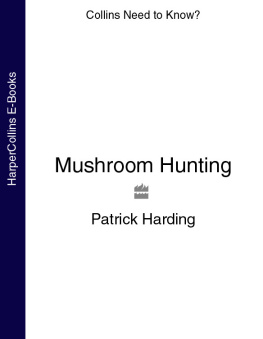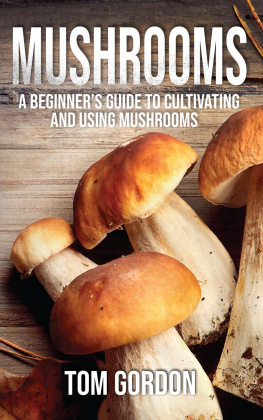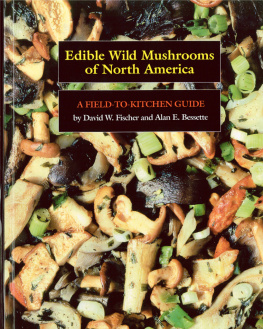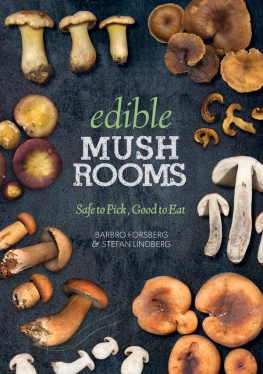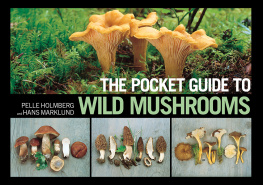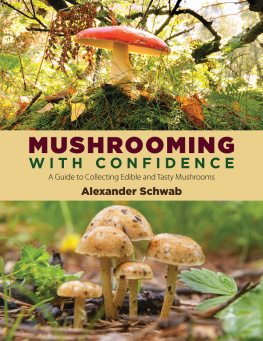The Publisher and the Author cannot accept responsibility for any identification of any mushroom made by the users of this guide. Although many species are edible for many people, some species cause allergic reactions or illnesses for certain individuals: these are totally unpredictable, therefore the Publisher and the Author cannot take responsibility for any effects resulting from eating any wild mushrooms. It is recommended that you consult your GP immediately if you experience such a reaction.
Contents
For thousands of years, living things were divided into just two separate kingdoms: plants and animals. Fungi, the scientific term for the group of organisms that includes edible mushrooms, were placed in the plant kingdom.

Plants like this foxglove are autotrophic they make their own food (initially sugars) using sunlight as an energy source. Plants are composed of cells that have rigid walls made of cellulose.
Like plants, fungi are rooted in places and they reproduce by spores that are comparable to those produced by ferns and mosses. Because fungi lack leaves (and so, unlike green plants, cannot manufacture carbohydrates using energy from sunlight), they were considered to be unusual plants.
Around 300 years ago it was proposed that, as fungi differed considerably from plants and animals, they should be placed in their own kingdom. However, it was not until the latter part of the 20th century that scientists fully embraced the idea of a separate fungal kingdom. Much of the media and general public still consider mushrooms to be plants, and mycologists (people who study fungi) mostly work in botanical gardens, university botany departments, or with forestry or agricultural institutes hence the plant link remains.
must know
Animals are heterotrophic which means that they require a food source, which they ingest and digest internally. Animal cells lack the rigid wall that plant cells have.
Fungi are also heterotrophic, but they digest and absorb their nutrients from external food sources, through tube-like threads called hyphae.
Within the fungal kingdom are thousands of visually insignificant species known as the microfungi. These include moulds, mildews and rusts. In contrast, the macrofungi produce their spores in a complex fruit body that is readily visible to the naked eye. A mushroom is a macrofungus whose large fruit body is collected and eaten.
Mushroom is a word with at least three different meanings. As used in the title of the Collins Gem Guide to Mushrooms, it embraces the macrofungi, including edible, inedible and poisonous species. The term mushroom is also used to refer solely to edible species such as the Parasol Mushroom, the remaining non-edible species (especially the poisonous ones) being called . As we shall see, some species of Agaricus are mildly toxic; to the mycologist these are poisonous mushrooms! In this book it is assumed that mushroom hunters will be looking for edible species (not all of which are in the genus Agaricus) but will also encounter other fungi. This is why the book includes a final section on poisonous species.

Branched Oyster Mushrooms ready for cleaning and cooking.

Agaricus campestris the edible and well-known Field Mushroom.

You dont need to be a scientist to be interested in mushrooms. More importantly, it isnt necessary to drive into the countryside to find them gardens, parks and playing fields all play host to a wide range of fungus species. For those intending to consume some of their finds, caution is the watchword, summed up in the saying: There are lots of bold mushroom hunters, but not many old, bold mushroom hunters.
In many countries such as France, Italy and Poland, mushroom hunting has long been a popular hobby and, for some people, also an important source of income.

Innovative mushroom hunters using a hat to collect St Georges Mushrooms.
Exactly why the British have a history of distaste for wild fungi in marked contrast to most of our European neighbours, is open to debate. The Pilgrim Fathers exported our distrust of fungi to America, where historically there has been a similar reluctance towards mushroom hunting.
An increased interest in mushroom hunting in Britain was initiated by the food shortages during and after World War II, when a number of booklets (including one published by the government) promoted the collection of wild mushrooms. At the same time, the integration of many Polish men who had fought alongside British troops in the war introduced people from a culture with a long history of using wild mushrooms as food. They must have been pleasantly surprised to find so little competition from the British!
In the late 1950s and through the 1960s, as Britain shook off the shortages of the immediate post-war days, the middle classes began to venture across the Channel for their holidays. There they found cheap wine and novel foods. In the French markets and Italian restaurants the British discovered that mushrooms were not restricted to the one or two species, as in the greengrocers back home.
British delicatessens began to increase their stock of tinned truffles and dried Ceps, but the general phobia surrounding the eating of self-collected wild mushrooms (with the exception of Field and Horse mushrooms) continued. One good reason for this, even as late as the 1970s, was the lack of good mushroom identification books aimed at the general public.
All this began to change in the 1980s, with the publication of a number of guides to identifying and the rise in popularity of the mushroom-loving Italian chef Antonio Carluccio. Even then, despite increased coverage on television, mushroom hunting was still very much a minority sport. During the 1990s, however, restaurateurs discovered the pulling power of wild mushroom dishes and commercial collecting became viable. At the same time, the choice of shop-bought species increased enormously and a number of books concentrating solely on the edible wild species were published.
Fortunately, attitudes have changed and more British people are now enjoying the delights of foraging for fungi as a source of free food.

A mushroom market stall in Brussels in 1984.
The publics increased fascination with mushrooms and toadstools is not confined to just those people with a culinary interest. For hundreds of years, mushrooms were associated with the Devil and the Antichrist. This view suppressed scientific work on fungi, and their classification as plants did little to help the situation.
Scientists had already discovered that fungi formed close relationships with trees, but it was not until towards the end of the 20th century that they began to realise that non-woody flowering plants, ferns and mosses also form close associations with fungi.
Next page
